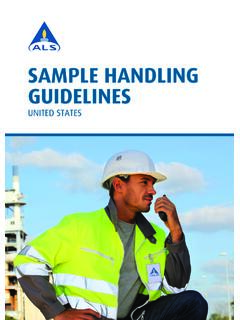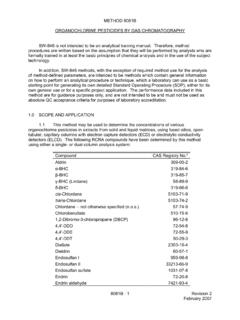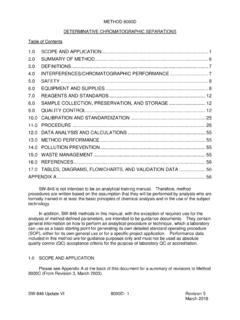Transcription of METHOD 8082A POLYCHLORINATED BIPHENYLS (PCBs) BY …
1 8082A - 1 Revision 1 February 2007 METHOD 8082 APOLYCHLORINATED BIPHENYLS (PCBs) BY GAS CHROMATOGRAPHYSW-846 is not intended to be an analytical training manual. Therefore, methodprocedures are written based on the assumption that they will be followed by individualsformally trained in at least the basic principles of chemical analysis and in the use of the addition, SW-846 methods , with the exception of required METHOD use for the analysisof METHOD -defined parameters, are intended to be methods which contain general informationon how to perform an analytical procedure or technique which a laboratory can use as a basicstarting point for generating its own detailed standard operating procedure (SOP), either for itsown general use or for a specific project application. The performance data included in thismethod are for guidance purposes only, and are not intended to be and must not be used asabsolute QC acceptance criteria for purposes of laboratory SCOPE AND METHOD may be used to determine the concentrations of polychlorinatedbiphenyls (PCBs) as Aroclors or as individual PCB congeners in extracts from solid, tissue, andaqueous matrices, using open-tubular, capillary columns with electron capture detectors (ECD)or electrolytic conductivity detectors (ELCD).
2 The Aroclors and PCB congeners listed belowhave been determined by this METHOD , using either a single- or dual column analysis system,and this METHOD may be appropriate for additional congeners and Aroclors (see Sec. ). Themethod also may be applied to other matrices such as oils and wipe samples, if appropriatesample extraction procedures are Registry #Aroclor 101612674-11-2-Aroclor 122111104-28-2-Aroclor 123211141-16-5-Aroclor 124253469-21-9-Aroclor 124812672-29-6-Aroclor 125411097-69-1-Aroclor 126011096-82-5-2-Chlorobiphenyl2051-60-7 12,3-Dichlorobiphenyl16605-91-752,2',5-T richlorobiphenyl37680-65-2182,4',5-Trich lorobiphenyl16606-02-3312,2',3,5'-Tetrac hlorobiphenyl41464-39-5442,2',5,5'-Tetra chlorobiphenyl35693-99-3522,3',4,4'-Tetr achlorobiphenyl32598-10-0662,2',3,4,5'-P entachlorobiphenyl38380-02-8872,2',4,5,5 '-Pentachlorobiphenyl37680-73-21012,3,3' ,4',6-Pentachlorobiphenyl38380-03-91102, 2',3,4,4',5'-Hexachlorobiphenyl35065-28- 21382,2',3,4,5,5'-Hexachlorobiphenyl5271 2-04-6141 CompoundCAS Registry # 8082A - 2 Revision 1 February 20072.
3 2',3,5,5',6-Hexachlorobiphenyl52663-63-5 1512,2',4,4',5,5'-Hexachlorobiphenyl3506 5-27-11532,2',3,3',4,4',5-Heptachlorobip henyl35065-30-61702,2',3,4,4',5,5'-Hepta chlorobiphenyl35065-29-31802,2',3,4,4',5 ',6-Heptachlorobiphenyl52663-69-11832,2' ,3,4',5,5',6-Heptachlorobiphenyl52663-68 -01872,2',3,3',4,4',5,5',6-Nonachlorobip henyl40186-72-9206aChemical Abstract Service Registry are multi-component mixtures. When samples contain more than oneAroclor, a higher level of analyst expertise is required to attain acceptable levels of qualitativeand quantitative analysis. The same is true of Aroclors that have been subjected toenvironmental degradation ("weathering") or degradation by treatment technologies. Suchweathered multi-component mixtures may have significant differences in peak patternscompared to those of Aroclor seven Aroclors listed in Sec.
4 Are those that are commonly specified in EPAregulations. The quantitation of PCBs as Aroclors is appropriate for many regulatorycompliance determinations, but is particularly difficult when the Aroclors have been weatheredby long exposure in the environment. Therefore, this METHOD provides procedures for thedetermination of a selected group of the 209 possible PCB congeners, as another means tomeasure the concentrations of weathered Aroclors. The 19 PCB congeners listed above havebeen tested by this METHOD and were chosen for testing because many of them representcongeners specific to the common Aroclor formulations (see Table 6). These 19 PCBcongeners do not represent the co-planar PCBs or the other PCBs of greatest toxicologicalsignificance. The analytical procedures for these 19 congeners may be appropriate for theanalysis of other congeners not specifically included in this METHOD and may be used asa template for the development of such a procedure.
5 However, all 209 PCB congenerscannot be separated using the GC columns and procedures described in this METHOD . If thisprocedure is expanded to encompass other congeners, then the analyst must either documentthe resolution of the congeners in question, or establish procedures for reporting the results ofcoeluting congeners that are appropriate for the intended PCB congener approach potentially affords greater quantitative accuracywhen PCBs are known to be present. As a result, this METHOD may be used to determineAroclors, some PCB congeners, or "total PCBs," depending on regulatory requirements andproject needs. The congener METHOD is of particular value in determining weathered Aroclors. However, analysts should use caution when using the congener METHOD when regulatoryrequirements are based on Aroclor concentrations. Also, this METHOD is not appropriate ascurrently written for the determination of the co-planar PCB congeners at the very low (sub partper trillion) concentrations sometimes needed for risk assessment identification based on single-column analysis should be confirmed ona second column, or should be supported by at least one other qualitative technique.
6 Thismethod describes analytical conditions for a second gas chromatographic column that can beused to confirm the measurements made with the primary column. GC/MS ( , METHOD 8270)is also recommended as a confirmation technique, if sensitivity permits (also see Sec. ofthis METHOD ). GC/AED may also be used as a confirmation technique, if sensitivity permits (seeMethod 8085). 8082A - 3 Revision 1 February METHOD includes a dual-column option that describes a hardwareconfiguration in which two GC columns are connected to a single injection port and to twoseparate detectors. The option allows one injection to be used for dual-column analyst must select columns, detectors and calibration procedures mostappropriate for the specific analytes of interest in a study. Matrix-specific performance datamust be established and the stability of the analytical system and instrument calibration must beestablished for each analytical matrix ( , hexane solutions from sample extractions, diluted oilsamples, etc.)
7 Example chromatograms and GC conditions are provided as to employing this METHOD , analysts are advised to consult the base methodfor each type of procedure that may be employed in the overall analysis ( , methods 3500,3600, and 8000) for additional information on quality control procedures, development of QCacceptance criteria, calculations, and general guidance. Analysts also should consult thedisclaimer statement at the front of the manual and the information in Chapter Two for guidanceon the intended flexibility in the choice of methods , apparatus, materials, reagents, andsupplies, and on the responsibilities of the analyst for demonstrating that the techniquesemployed are appropriate for the analytes of interest, in the matrix of interest, and at the levelsof addition, analysts and data users are advised that, except where explicitly specified in aregulation, the use of SW-846 methods is not mandatory in response to Federal testingrequirements.
8 The information contained in this METHOD is provided by EPA as guidance to beused by the analyst and the regulated community in making judgments necessary to generateresults that meet the data quality objectives for the intended of this METHOD is restricted to use by, or under the supervision of, personnelappropriately experienced and trained in the use of gas chromatographs (GCs) and skilled inthe interpretation of gas chromatograms. Each analyst must demonstrate the ability to generateacceptable results with this SUMMARY OF measured volume or weight of sample is extracted using the appropriate matrix-specific sample extraction samples may be extracted at neutral pH with methylene chlorideusing either METHOD 3510 (separatory funnel), METHOD 3520 (continuous liquid-liquidextractor), METHOD 3535 (solid-phase extraction), or other appropriate technique samples may be extracted with hexane-acetone (1:1) or methylenechloride-acetone (1.)
9 1) using METHOD 3540 (Soxhlet), METHOD 3541 (automated Soxhlet), METHOD 3545 (pressurized fluid extraction), METHOD 3546 (microwave extraction), Method3550 (ultrasonic extraction), METHOD 3562 (supercritical fluid extraction), or otherappropriate technique or samples may be extracted using METHOD 3562 (supercritical fluidextraction), or other appropriate technique. The extraction techniques for other solidmatrices (see Sec. ) may be appropriate for tissue - 4 Revision 1 February for PCB analysis may be subjected to a sequential sulfuric acid/potassiumpermanganate cleanup ( METHOD 3665) designed specifically for these analytes. This cleanuptechnique will remove (destroy) many single component organochlorine or organophosphoruspesticides. Therefore, this METHOD is not applicable to the analysis of those compounds. Instead, use METHOD cleanup, the extract is analyzed by injecting a measured aliquot into a gaschromatograph equipped with either a narrow- or wide-bore fused-silica capillary column andeither an electron capture detector (GC/ECD) or an electrolytic conductivity detector(GC/ELCD).
10 Chromatographic data may be used to determine the seven Aroclors in , selected individual PCB congeners, or total PCBs (see Secs. and ). DEFINITIONSR efer to Chapter One and the manufacturer's instructions for definitions that may berelevant to this , reagents, glassware, and other sample processing hardware may yieldartifacts and/or interferences to sample analysis. All of these materials must be demonstratedto be free from interferences under the conditions of the analysis by analyzing METHOD blanks. Specific selection of reagents and purification of solvents by distillation in all-glass systems maybe necessary. Refer to each METHOD to be used for specific guidance on quality controlprocedures and to Chapter Four for general guidance on the cleaning of glassware. Also referto methods 3500, 3600, and 8000 for a discussion of co-extracted from the samples will vary considerably from matrix tomatrix.












